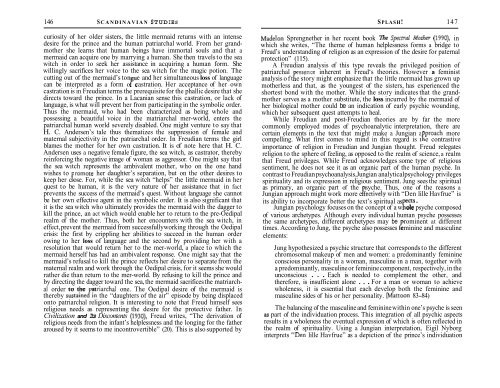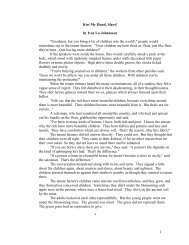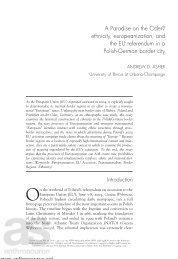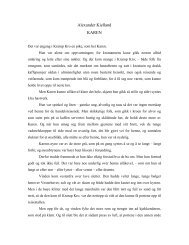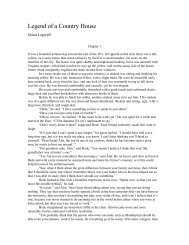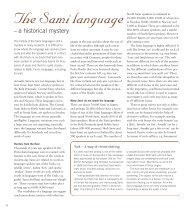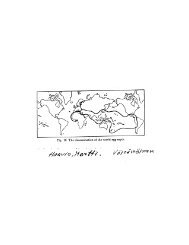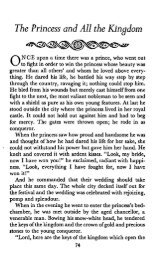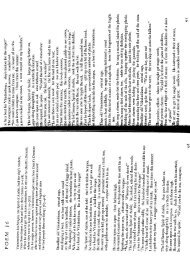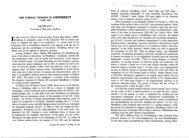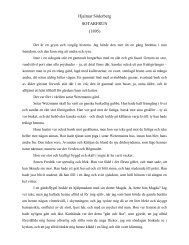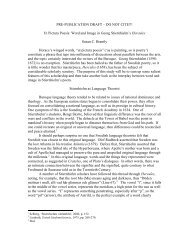Six Views of “The Little Mermaid” - Department of Scandinavian ...
Six Views of “The Little Mermaid” - Department of Scandinavian ...
Six Views of “The Little Mermaid” - Department of Scandinavian ...
You also want an ePaper? Increase the reach of your titles
YUMPU automatically turns print PDFs into web optimized ePapers that Google loves.
146 SCANDINAVIAN STUDIES SPLASH! 147<br />
curiosity <strong>of</strong> her older sisters, the little mermaid returns with an intense<br />
desire for the prince and the human patriarchal world. From her grandmother<br />
she learns that human beings have immortal souls and that a<br />
mermaid can acquire one by marrying a human. She then travels to the sea<br />
witch in order to seek her assistance in acquiring a human form. She<br />
willingly sacrifices her voice to the sea witch for the magic potion. The<br />
cutting out <strong>of</strong> the mermaid’s ton e and her simultaneous loss <strong>of</strong> language<br />
r<br />
can be interpreted as a form o castration. Her acceptance <strong>of</strong> her own<br />
castration is in Freudian terms the prerequisite for the phallic desire that she<br />
directs toward the prince. In a Lacanian sense this castration, or lack <strong>of</strong><br />
language, is what will prevent her from participating in the symbolic order.<br />
Thus the mermaid, who had been characterized as being whole and<br />
possessing a beautiful voice in the matriarchal mer-world, enters the<br />
patriarchal human world severely disabled. One might venture to say that<br />
H. C. Andersen’s tale thus thematizes the suppression <strong>of</strong> female and<br />
maternal subjectivity in the patriarchal order. In Freudian terms the girl<br />
blames the mother for her own castration. It is <strong>of</strong> note here that H. C.<br />
Andersen uses a negative female figure, the sea witch, as castrator, thereby<br />
reinforcing the negative image <strong>of</strong> woman as aggressor. One might say that<br />
the sea witch represents the ambivalent mother, who on the one hand<br />
wishes to romote her daughter’s separation, but on the other desires to<br />
keep her c P ose. For, while the sea witch “helps” the little mermaid in her<br />
quest to be human, it is the very nature <strong>of</strong> her assistance that in fact<br />
prevents the success <strong>of</strong> the mermaid’s quest. Without language she cannot<br />
be her own effective agent in the symbolic order. It is also significant that<br />
it is the sea witch who ultimately provides the mermaid with the dagger to<br />
kill the prince, an act which would enable her to return to the pre-Oedipal<br />
realm <strong>of</strong> the mother. Thus, both her encounters with the sea witch, in<br />
effect, prevent the mermaid from successfully working through the Oedipal<br />
crisis: the first by crippling her abilities to succeed in the human order<br />
owing to her loss <strong>of</strong> language and the second by providing her with a<br />
resolution that would return her to the mer-world, a place to which the<br />
mermaid herself has had an ambivalent response. One might say that the<br />
mermaid’s refusal to kill the prince reflects her desire to separate from the<br />
maternal realm and work through the Oedipal crisis, for it seems she would<br />
rather die than return to the mer-world. By refusing to kill the prince and<br />
by directing the dagger toward the sea, the mermaid sacrifices the matriarch-<br />
al order to the atriarchal one. The Oedipal desire <strong>of</strong> the mermaid is<br />
thereby sustainelin the “daughters <strong>of</strong> the air” episode by being displaced<br />
onto patriarchal religion. It is interesting to note that Freud himself sees<br />
religious needs as representing the desire for the protective father. In<br />
Civilization and Its Discontents (1930), Freud writes, <strong>“The</strong> derivation <strong>of</strong><br />
religious needs from the infant’s helplessness and the longing for the father<br />
aroused by it seems to me incontrovertible” (20). This is also supported by<br />
Madelon Sprengnether in her recent book Be S’d Mother (1990), in<br />
which she writes, <strong>“The</strong> theme <strong>of</strong> human helplessness forms a bridge to<br />
Freud’s understanding <strong>of</strong> religion as an expression <strong>of</strong> the desire for paternal<br />
protection” (115).<br />
A Freudian analysis <strong>of</strong> this type reveals the privileged position <strong>of</strong><br />
patriarchal resence inherent in Freud‘s theories. However a feminist<br />
analysis <strong>of</strong>t fl e story might emphasize that the little mermaid has grown up<br />
motherless and that, as the youngest <strong>of</strong> the sisters, has experienced the<br />
shortest bond with the mother. While the story indicates that the grandmother<br />
serves as a mother substitute, the loss incurred by the mermaid <strong>of</strong><br />
her biological mother could be an indication <strong>of</strong> early psychic wounding,<br />
which her subsequent quest attempts to heal.<br />
While Freudian and post-Freudian theories are by far the more<br />
commonly employed modes <strong>of</strong> psychoanalytic interpretation, there are<br />
certain elements in the text that might make a Jungian a proach more<br />
compelling. What first comes to mind in this regard is t g e contrastive<br />
importance <strong>of</strong> religion in Freudian and Jungian thought. Freud relegates<br />
religion to the sphere <strong>of</strong> feeling, as opposed to the realm <strong>of</strong> science, a realm<br />
that Freud privileges. While Freud acknowledges some type <strong>of</strong> religious<br />
sentiment, he does not see it as an organic part <strong>of</strong> the human psyche. In<br />
contrast to Freudian psychoanalysis, Jungian analytical psychology privileges<br />
spirituality and its expression in religious sentiment. Jung sees the spiritual<br />
as primary, an organic part <strong>of</strong> the syche. Thus, one <strong>of</strong> the reasons a<br />
Jungian approach might work more e Ff eaively with “Den lille Havfrue” is<br />
its ability to incorporate better the text’s spiritual as .<br />
Jungian psychology focuses on the concept <strong>of</strong> a w rcts ole psyche composed<br />
<strong>of</strong> various archetypes. Although every individual human psyche possesses<br />
the same archetypes, different archetypes may be rominent at different<br />
times. According to Jung, the psyche also possesses P eminine and masculine<br />
elements:<br />
Jung hypothesized a psychic structure that corresponds to the different<br />
chromosomal makeup <strong>of</strong> men and women: a predominantly feminine<br />
conscious personality in a woman, masculine in a man, together with<br />
a predominantly, masculine or feminine component, respectively, in the<br />
unconscious . . . Each is needed to complement the other, and<br />
therefore, is insufficient alone . . . For a man or woman to achieve<br />
wholeness, it is essential that each develop both the feminine and<br />
masculine sides <strong>of</strong> his or her personality. (Mattoon 83-84)<br />
The balancing <strong>of</strong> the masculine and feminine within one’s psyche is seen<br />
as part <strong>of</strong> the individuation process. This integration <strong>of</strong> all psychic aspects<br />
results in a wholeness the eventual expression <strong>of</strong> which is <strong>of</strong>ten reflected in<br />
the realm <strong>of</strong> spirituality. Using a Jungian interpretation, Eigil Nyborg<br />
interprets “Den lille Havfrue” as a depiction <strong>of</strong> the prince’s individuation


